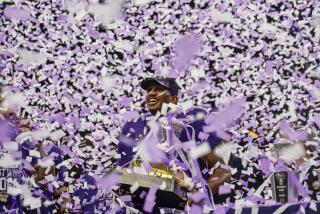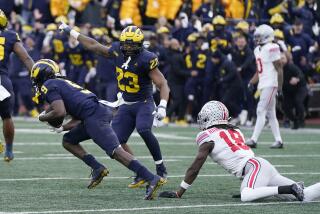Pac-10 Start Has Been Real Turn-Off
- Share via
Live television has always been risky business. Ask Milton Berle.
Or, this year, the Pacific 10 Conference.
With cameras rolling, the Pac-10 has been caught staring dumbstruck into a bank of Klieg lights.
Cut to commercial!
Hoping to amend UCLA’s dismal defensive displays against Miami and Wisconsin last season, the Pac-10 instead has tap-danced onto the national stage and fallen face-first into the orchestra pit.
The Pac-10 is 9-7 in nonconference games, but 2-7 in games televised nationally or regionally.
Average score in those games?
Nonconference 36.6, Pac-10 18.3.
The defeats have left East Coast writers giggling in press boxes and Pac-10 defenders donning flak jackets.
“I hear it,” Tom Ramsey, the former UCLA quarterback and Pac-10 television analyst for Fox Sports Net, said. “I get e-mails, phone calls, ‘Hey man, what’s going on with your conference?’ ”
Here’s what’s been going on:
* Penn State 41, Arizona 7.
* Nebraska 45, California 0.
* Texas 69, Stanford 17.
* Brigham Young 35, Washington 28.
* Utah 27, Washington State 7.
* Ohio State 42, UCLA 20.
In one of the Pac-10’s TV victories, Arizona had to scramble from an 18-point deficit to beat Texas Christian, a 17-7 loser last weekend to Northwestern.
Arizona State, a 31-13 victor over Texas Tech, has been the only Pac-10 school to make a significant nonconference stand.
Pac-10 coaches warn that it’s too early to consider a merger with Conference USA.
“I think the Pac-10 will be fine when the dust settles,” first-year Washington Coach Rick Neuheisel said.
But damage has been done in terms of national credibility and, perhaps, recruiting.
“I don’t know that it impacts the West Coast kid,” Arizona State Coach Bruce Snyder said, “but if you decide to recruit Chicago, or the East Coast, you’d like to go in with a pretty strong deck of cards to play. If the national image is not strong, it weakens the deal.”
What’s wrong with the Pac-10?
First, the facts: The conference has produced more NFL players, 313, in the 1990s than any other conference. In recent years, UCLA and Arizona State have flirted with national titles while Washington State went throw-to-throw with co-national champion Michigan in the 1998 Rose Bowl.
Last year, the Pac-10 went 25-12 against nonconference opponents.
Now, five theories to explain this year’s collapse:
1. Bad scheduling. The key Pac-10 defeats have all been on the road: at Penn State, Texas, Ohio State, Nebraska, Michigan State, and Brigham Young, six of the toughest places in the country to play.
2. Loss of star power. This is Ramsey’s theory: The quarterback-driven conference lost three of its pillars in UCLA’s Cade McNown, Oregon’s Akili Smith and Brock Huard of Washington. Add memo to Cal: Nebraska is not the place to break in a couple of new quarterbacks.
3. Cheapskate theory. Neuheisel wonders: “Most of the major conferences travel 66 players, we travel 60. And why do most conferences have yearlong training tables and we only have it during the football season?”
4. Where’s the beef? This is my theory. Pac-10 defenses are built to stop explosive Pac-10 offenses, not corn-fed running games. In big games against big men, Pac-10 players tend to stack up like Richard Simmons’ deal-a-meal graduates. Take note: Of the 29 defensive linemen drafted in the NFL’s first round since 1996, only three hailed from Pac-10 schools.
“I think that probably has something to do with it,” Washington State Coach Mike Price said. “We need guys that can run, and run fast. We don’t have a bunch of linebackers that play tackle to tackle, in the box.”
Washington State nearly upset Michigan in the Rose Bowl because the Cougars had enough speed to offset the Wolverines’ strength.
“If we had to play that game in a phone booth, we might have got our butts kicked,” Price said.
5. Sabotage? OK, this may only explain Oregon’s 27-20 recent loss at Michigan State. Duck Coach Mike Bellotti said this week that a Eugene cyber-reporter posted the team’s game plan on his Web site.
The tip-off?
Bellotti: “It was given to me actually by an assistant coach from Michigan State, who said, ‘Coach, I just want you to know here’s what we’re getting off the Internet about what you’re doing in practice.’
“I was shocked.”
Little can be done to repair the Pac-10’s credibility this season.
The conference has precious few marquee moments remaining: Colorado at Washington on Sept. 25; Arizona State at Notre Dame on Oct. 9; USC at Notre Dame on Oct. 16.
A sweep of those games would be a start toward redemption.
The best-case scenario would be Arizona avenging its loss to Penn State in the Rose Bowl.
WALLET WALLOP
Last-minute blunders might end up costing Notre Dame $26 million in bowl checks.
Last November, protecting a 39-36 lead against Louisiana State, quarterback Jarious Jackson tore knee ligaments when he was blindsided while taking an intentional safety with eight seconds left.
Without Jackson, Notre Dame lost to USC, 10-0, and was aced out of a $13-million bowl championship series bowl game. Notre Dame settled instead for a Gator Bowl defeat.
Two last-minute losses this season have severely damaged Notre Dame’s BCS chances.
In defeats against Michigan and Purdue, the Irish offense was unable to get a snap off before the clock ran out.
Didn’t someone, Knute Rockne perhaps, once say football was a game of inches?
“If you talk about 11 more yards, 10 yards against Michigan and one yard against Purdue, we could be sitting here now as a football team that is probably in the top five in the country,” Irish Coach Bob Davie lamented of his 24th-ranked team.
Notre Dame (1-2) has to win eight of its remaining nine games to have the nine victories required for BCS participation. One of those games is a Nov. 6 trip to Tennessee.
Goodbye, BCS; hello again, Gator Bowl.
BRIDE OF CLOCKENSTEIN
There is no truth to the rumor Carolina Panther linebacker Kevin Greene flew to Texas this week to choke Coach Kevin Steele again.
OK, cruel joke, but one of the many Steele has endured since Baylor’s wacko finish Saturday night in Waco.
Steele plucked defeat from the jaws of victory when, instead of ordering his quarterback to take a knee and run out the clock to preserve a sure 24-21 victory over Nevada Las Vegas, the first-year Baylor coach called a running play at the UNLV eight-yard line with less than 20 seconds left.
Darrel Bush fumbled, and UNLV’s Kevin Thomas picked up the loose ball and raced 99 yards for the game-winning touchdown.
Ouch.
“It was a mistake, and I’m sorry it happened,” Steele said this week. “I regret it for Baylor and the kids.”
Steele admits he was trying to score a meaningless touchdown, not to pile it on his opponent, rather to help build confidence for a team that finished 2-9 last season.
It has been a short honeymoon. Steele lost his Sept. 4 debut when Kyle Atteberry missed an extra point in overtime against Boston College.
Steele is making news for the wrong reasons. Last December, he became highlight fodder when Greene choked Steele, then a Panther assistant coach, on the sideline during a game against the Washington Redskins.
Saturday’s coaching gaffe has to rate as the worst since New York Giant offensive coordinator Bob Gibson called down “Pro-65 Up” from the press box in the waning moments of a 1978 game against Philadelphia.
Instead of taking a knee and killing a 17-12 win, Giant quarterback Joe Pisarcik bungled a handoff to Larry Csonka, and Eagle defensive back Herman Edwards returned the fumble 26 yards for the game-winner.
The good news for Steele: He has already held his job longer than Gibson did after his bonehead call.
Gibson was fired the next day.
HURRY-UP OFFENSE
* If Southern Methodist and Texas Christian leave the Western Athletic Conference for Conference USA, as is widely speculated, it probably would cause a ripple effect that would lead to the demise of the Big West as a football conference. The WAC has already swiped Nevada Reno from the Big West--the Wolf Pack will make the switch next season. If TCU and SMU leave the WAC, the conference would likely raid the Big West of at least Boise State and Utah State, leaving the Big West as a . . . basketball conference.
* Florida State’s Sebastian Janikowski booted six consecutive kickoffs into the end zone Saturday against Georgia Tech, two of the balls sailing through the uprights at a distance of 75 yards.
Reaction: Where was this guy when Bobby Bowden really needed him?
Once, the legendary Florida State coach didn’t believe in wasting a scholarship on a kicker, but then came those life-altering experiences.
“Probably a couple of wide rights will help you a little bit,” Bowden said of his decision-making process.
Missed field goals against Miami in 1991 and ’92 cost Florida State undefeated seasons.
More Bowden: The 69-year-old coach is expected to soon sign a new five-year contract that will push his package from $1 million a season to $1.5 million, with a chance to earn an additional $300,000 in incentives.
* So much for that tough opener. . . . Defending Division III champion Mount Union (Ohio) defeated Albion (Michigan) on Saturday, 38-0, extending the Purple Raiders’ winning streak to 43 games. Mount Union is five victories shy of breaking Oklahoma’s NCAA record of 47 consecutive wins.
More to Read
Go beyond the scoreboard
Get the latest on L.A.'s teams in the daily Sports Report newsletter.
You may occasionally receive promotional content from the Los Angeles Times.







